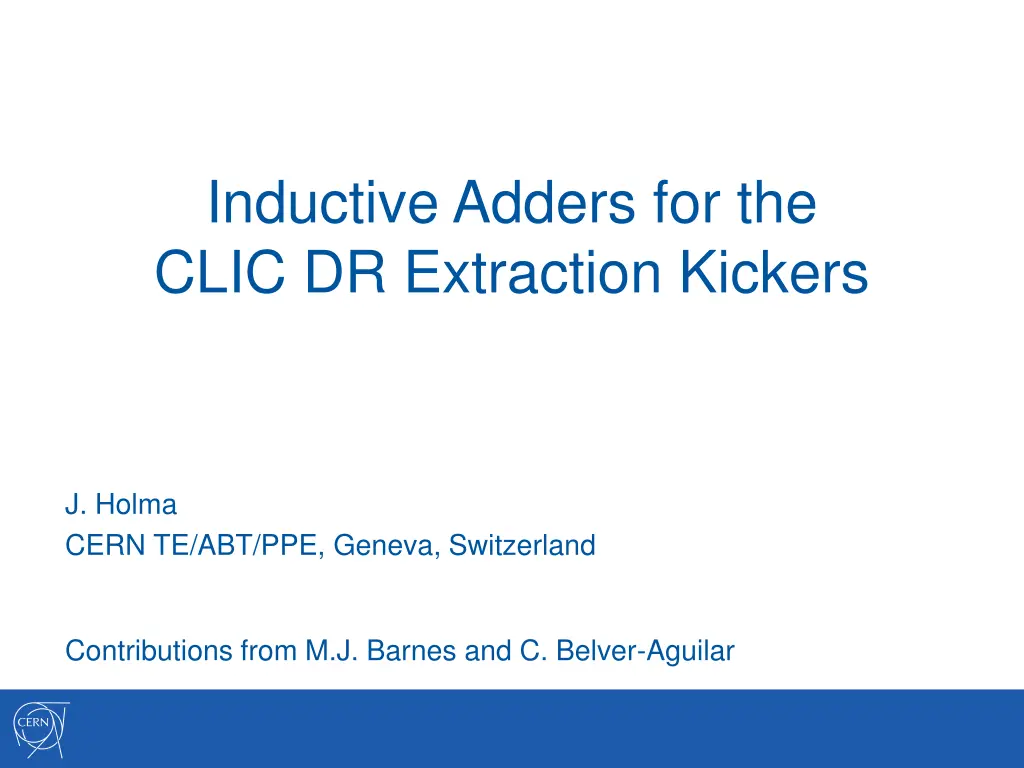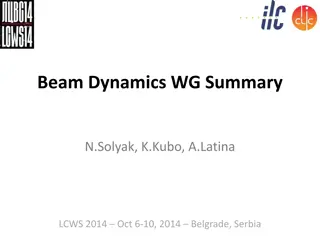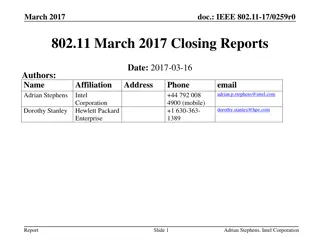
Inductive Adders for CLIC DR Extraction Kickers - Overview
Explore the specifications, methods, and challenges of inductive adders in CLIC DR extraction kicker modulators for precise beam control and stability. Learn about waveform stability, repeatability, and optimization techniques.
Download Presentation

Please find below an Image/Link to download the presentation.
The content on the website is provided AS IS for your information and personal use only. It may not be sold, licensed, or shared on other websites without obtaining consent from the author. If you encounter any issues during the download, it is possible that the publisher has removed the file from their server.
You are allowed to download the files provided on this website for personal or commercial use, subject to the condition that they are used lawfully. All files are the property of their respective owners.
The content on the website is provided AS IS for your information and personal use only. It may not be sold, licensed, or shared on other websites without obtaining consent from the author.
E N D
Presentation Transcript
Inductive Adders for the CLIC DR Extraction Kickers J. Holma CERN TE/ABT/PPE, Geneva, Switzerland Contributions from M.J. Barnes and C. Belver-Aguilar
Outline Background and Motivation Specifications for CLIC DR Extraction Kicker Modulator Inductive Adder Schematic and Features Methods to Improve the Pulse Flat- top Stability Prototyping and Measurements Prototypes 1-4 Measurements on a Flat-top Pulse Measurements on a Controlled Decay Waveform Measurement Techniques Summary and Future Work 24/10/2017 J. Holma LCWS 2017 2
Specifications for CLIC DR Extraction Kicker Systems CLIC DR (1 GHz | 2 GHz) Pulse voltage (per electrode) 12.5 kV 309 A Electrode pulse current [40.5 load] Repetition rate 50 Hz Pulse flat-top duration *900 ns = 160 ns + 580 ns gap + 160 ns ~160 ns | ~900* ns Stripline kicker: two electrodes, powered with opposite polarities Both electric and magnetic fields deflect the beam. Impedances of the striplines are 50 ? ? when off and 40.5? ? when on : 1x10-4 ( 0.01 %) 2x10-4 ( 0.02 %) Flat-top repeatability Flat-top stability [droop+ripple] Field rise time 1000 ns (max.) Field fall time 1000 ns (max.) 2.86 GeV Beam energy 1.5 mrad (0.09 deg) Total kick deflection angle 20 mm Aperture 1.7 m Effective length 0.01 % Field inhomogeneity [1 mm radius] Extremely tight requirements for flat-top stability and repeatability! For rise/fall times, 100 ns desired. CLIC DR kicker pulse definition 24/10/2017 J. Holma LCWS 2017 3
Specifications for the CLIC DR Extraction Kicker Modulators: Waveform stability & repeatability Simplified schematic of a CLIC DR stripline kicker system 3D model of the CLIC DR stripline electrodes Stripline kicker: both electric and magnetic fields deflect the beam. Impedances of the striplines are 50 ? ?when off and 40.5? ?when on : both modes are matched with a terminating resistor network. The total deflecting angle for particles in each bunch during a single kick should be the same. According to optimization studies of the CLIC DR prototype stripline kicker (by C. Belver- Aguilar), the impedance of the kicker changes during the pulse: in order to generate the same deflection for each bunch, the voltage and current need to be modulated. The optimum waveforms for both stripline electrodes are identical controlled decays : these generate a constant flat-top for total deflecting field. 24/10/2017 J. Holma LCWS 2017 4
Specifications for the CLIC DR Extraction Kicker Modulators: Waveform stability & repeatability CLIC DR (1 GHz | 2 GHz) Pulse voltage (per electrode) 12.5 kV 309 A Stripline pulse current [40.5 load] Repetition rate 50 Hz Pulse waveform duration *900 ns = 160 ns + 580 ns gap + 160 ns ~160 ns | ~900* ns 1x10-4 ( 0.01 %) Waveform repeatability 2x10-4 ( 0.02 %) Waveform stability Voltage rise/fall time < 1000 ns The required waveforms (for each electrode) are controlled decays. Definitions for waveform parameters Repeatability: difference of amplitudes of any two waveforms during the flat-top of the pulse (160 | 900 ns) Stability: difference between the optimum waveform and a generated waveform at any time point during the flat-top of the pulse. Extremely tight requirements for waveform stability and repeatability! For rise/fall times, 100 ns desired 24/10/2017 J. Holma LCWS 2017 5
Goals and Challenges As part of feasibility study of CLIC, the following goals have been set: 1. Identifying the most suitable topology for the CLIC DR kicker modulator. 2. Proposal for possible means for achieving the required performance regarding flat- top stability and repeatability. 3. Design, manufacturing and testing of the prototype pulse modulator. 4. Design and manufacturing of two full-scale modulators and, finally, testing of them in a beamline with the prototype stripline kicker. Challenges 0.02 % ( 2.5 V) requirement for the flat-top/waveform stability at 12.5 kV for 160- 900 ns is an extremely demanding specification: an order of magnitude better than in any existing kicker systems! E.g. for the LHC injection kickers, stability requirement is 0.5 %. Impedance mismatch: even-mode impedance 50 ?, odd-mode impedance ~40.5 ?! How to generate the required waveform? How to measure it? Evolution of parameters Prototypes 1&2 (2012-): 160 ns flat-top, 50 ? load Prototype 3 (2015-): ~900 ns flat-top, 40.9 ? load Prototypes 4&5 (full-scale) (2017-): 900 ns controlled decay waveform , 12.5 kV, 40.5 ? load (309 A) + option for 17.5 kV, 400 A (extraction + dump kicker). 24/10/2017 J. Holma LCWS 2017 6
Topology: Inductive Adder Many primary layers , each with solid-state switches The output voltage is approximately the sum of the voltages of the primary constant voltage layers +The output voltage can be modulated during the pulse by passive/active analogue modulation. + Possibility to generate positive or negative output pulses with the same adder: the polarity of the ouput pulses can be easily changed by grounding the other end of the output of the adder + All control electronics referenced to ground potential. + Built-in fault tolerancy and redundancy: if one switch or layer fails, the adder still gives full voltage or a significant portion of the required output pulse (good for the machine safety). + Modularity: the same design can potentially be used for kickers with different specifications (CLIC PDR & DR kicker modulators, extraction + dump kicker) Magnetic material Pulse capacitor MOSFET switch PCB Secondary 24/10/2017 J. Holma LCWS 2017 7
Improving the Pulse Flat-top Stability: Passive and Active Modulation Droop and ripple of the output pulse can be compensated with an analogue modulation layer In the analogue modulation layer, resistor Ra is effectively in series with the load The load voltage is the sum of the voltages across all of the layers. Two modes: Passive mode: During the pulse, current through Lm increases, which causes current through Ra to decrease. Therefore, voltage over Ra decreases, which can compensate for a reduction in the primary voltage (i.e. droop) of the other layers. Lm Ra VMax Passive analogue modulation 24/10/2017 J. Holma LCWS 2017 8
Improving the Pulse Flat-top Stability: Passive and Active Modulation Droop and ripple of the output pulse can be compensated with an analogue modulation layer In the analogue modulation layer, resistor Ra is effectively in series with the load The load voltage is the sum of the voltages across all of the layers. Two modes: Passive mode: During the pulse, current through Lm increases, which causes current through Ra to decrease. Therefore, voltage over Ra decreases, which can compensate for a reduction in the primary voltage (i.e. droop) of the other layers. Active mode: A linear RF power transistor in parallel with resistor Ra. The voltage across Ra can be controlled by modulating the current through the RF power transistor. Lm Ra RF Power Transistor VMax Active analogue modulation 24/10/2017 J. Holma LCWS 2017 9
The First Two 5-Layer Prototype Inductive Adders The purposes of the prototype inductive adders have been: To verify experimentally theoretical models and design steps for an inductive adder with extremely high flat-top stability. To test and evaluate main components (MOSFETs, pulse capacitors, magnetic cores) To test both passive and active analogue modulation To approach the required 0.02 % flat-top stability for the output pulse, as specified for the CLIC DR extraction kicker system To evaluate magnetic core material for the 12.5 kV prototype inductive adder Status: available as a test bench: 3.5 kV, 70-250 A, 250-900 ns, up to 50 Hz. Design Parameter Prototype Inductive Adder CLIC DR Extraction Kicker Modulator Output Voltage (kV) 3.5 12.5 Output Current [50 load] (A) 70 (250) 250 Voltage per layer 700 700 Number of layers 5 20 Pulse flat-top duration (ns) Up to 900 160 900 Pulse rise time [0.1-99.9 %] (ns) 100 < 1000 Pulse fall time [0.1-99.9 %] (ns) 100 < 1000 Targe flat-top stability (for 160 ns) 0.02 % 0.02 % Repetition rate (Hz) Up to 50 50 24/10/2017 J. Holma LCWS 2017 10
Measurements on Prototypes 1&2 (2014) Setup for the measurement: Vacuumschmelze W567 cores 4 constant voltage layers 1 active analogue modulation layer 1 branch powered per half-layer PCB, 2 branches per layer Capacitors (24 F/layer) initially charged to 551 V Active compensation of droop and ripple Measurements with a 8-bit oscilloscope (average of 1000 pulses) 0.05 % ( 1 V) flat-top stability over 160 ns at 1.8 kV 24/10/2017 J. Holma LCWS 2017 11
Prototype 3: the First 5 Full-scale Layers of the 12.5 kV, 20-layer, Inductive Adder 5-layers, otherwise identical design with 20-layer, 12.5 kV CLIC DR extraction kicker inductive adder. Specifications according to requirements for CLIC DR extraction kicker. Target flat-top stability 0.02 % for 900 ns, target flat-top repeatability 0.01 % for 900 ns. Status: in operation, used as a test bench for printed circuit boards (PCBs) and magnetic cores. Design Parameter 5-Layer Full-Scale Prototype CLIC DR Extraction Kicker Modulator Output Voltage (kV) 3.5 12.5 Output Current 308* 250 Voltage per layer 700 700 Number of layers 5 20 Pulse flat-top duration (ns) 1100 160 900 Pulse rise time [0.1-99.9 %] (ns) 100 < 1000 Pulse fall time [0.1-99.9 %] (ns) 100 < 1000 First 5 layers of the 12.5 kV inductive adder assembled at CERN Flat-top stability (for 900* ns) 0.02 % 0.02 % Flat-top repeatability (for 900* ns) *Stripline odd-mode impedance 40.5 ? 0.01 % 0.01 % 24/10/2017 J. Holma LCWS 2017 12
Measurements on Prototype 3 (2016) New 3.5 kV, 5-layer, full-scale inductive adder prototype 2nd inductive adder with an analogue modulation layer only (in series with the 3.5 kV inductive adder) Setup for the measurement: 5 constant voltage layers, Finemet FT-3L cores 1 active analogue modulation layer 1 branch powered per half-layer PCB Capacitors (24 F/layer) initially charged to 555 V Active compensation of droop (not ripple) Measurements with a 16-bit (effective) oscilloscope! Flat-top stability 0.01% ( 0.3 V) over 160 ns, 0.04% ( 0.3 V) over 900 ns, at 2.4 kV. CLIC DR specifications: 0.02% ( 2.5 V) for 160|900 ns (1 GHz|2 GHz) at 12.5 kV 24/10/2017 J. Holma LCWS 2017 13
Prototype 4: Full-Scale,12.5 kV, 20-layer, Inductive Adder for CLIC DR Extraction Kicker System Specifications according to requirements for CLIC DR extraction kicker: Target waveform stability 0.02 % for 900 ns at 12.5 kV Target waveform repeatability 0.01 % for 900 ns at 12.5 kV Status: assembled, measurements carried out with up to 17 constant voltage layers + 1 analogue modulation layer until now. Design Parameter 20-Layer Full-Scale Prototype CLIC DR Extraction Kicker Modulator Output Voltage (kV) 12.5 12.5 Output Current 308* 250 Voltage per layer 700 700 Number of layers 20 20 Pulse flat-top duration (ns) 1100 160 900 Pulse rise time [0.1-99.9 %] (ns) 100 < 1000 Pulse fall time [0.1-99.9 %] (ns) 100 < 1000 Flat-top stability (for 900* ns) 0.02 % 0.02 % Flat-top repeatability(for 900* ns) 0.01 % 0.01 % *Stripline odd-mode impedance 40.5 ? 24/10/2017 J. Holma LCWS 2017 14
Prototype 4: Pulse without Modulation Height 120 cm Setup for the measurement: 20-layer prototype inductive adder 10 constant voltage layers, with half-layer PCBs 4 branches powered per layer, capacitors (48 F/layer) initially charged to 700 V. No modulation applied Output voltage 6.8 kV, droop ~15 V for 600 ns. Flat-top stability w/o compensation: 0.1 % ( 8.0 V) over 800 ns, at 6.8 kV 24/10/2017 J. Holma LCWS 2017 15
Prototype 4: Flat-top Pulse, with Modulation Primary of the active analogue modulation layer 0.02 % 160 ns 160 ns 580 ns Setup for the measurement: 20-layer prototype inductive adder 17 constant voltage layers, with half-layer PCBs 4 branches powered per layer, capacitors (48 F/layer) initially charged to 400 V. 1 active analogue modulation layer Active compensation of droop and ripple Output voltage 6.3 kV 0.02 % 0.03 % Until recently, the specifications called for a flat-top pulse. Manually tuned compensation, not yet fully optimised: could possibly be improved e.g. by applying frequency domain compensation, with Fast Fourier Transform analysis. Flat-top stability: 0.02 % ( 1.6 V) over 900 ns at 6.3 kV: CLIC DR 1 and 2 GHZ specifications at a half of the nominal voltage. 24/10/2017 J. Holma LCWS 2017 16
Prototype 4: Attempt at Optimum Controlled Decay Waveform Setup for the measurement: 20-layer prototype inductive adder 17 constant voltage layers, with half-layer PCBs 4 branches powered per layer, capacitors (48 F/layer) initially charged to 700 V. 1 active analogue modulation layer Active modulation applied to adjust the flat-top to a controlled decay Output voltage 6.3 kV Maximum difference between the simulated, optimum waveform and measured waveform: 0.05 % ( 6.3 V) at 6.3 kV (a half of the nominal voltage). Manually tuned compensation, not optimised: can be improved e.g. applying frequency domain compensation, with Fast Fourier Transform analysis. Target for next measurements: maximum difference within 0.02 % of the optimum decay waveform, according to CLIC DR kicker stability specifications. 24/10/2017 J. Holma LCWS 2017 17
Measurement Techniques Applied for Testing CLIC DR Inductive Adders Measurements shown in previous slides were carried out with a current tranformer and 16-bit (effective) high-end oscilloscope, i.e. with direct electrical measurement. Limits: channel noise of Rohde&Schwarz 16-bit (effective) oscilloscope RTO1004 is approximately 0.2 % of the range (min/max envelopes for e.g. 100 pulses). Averaging (e.g. 100 or 1000 pulses) applied to filter out asynchronous, arbitrary, noise. However, it is impossible to define 1) stability of a single waveform, and 2) repeatability (min/max envelopes) if smaller than 0.2 % of the channel range. Other techniques applied: Pulse cancelling method Balanced measurement setup (borrowed from PSI, Switzerland) Final measurements will be carried out with two full-scale prototype inductive adders powering a prototype stripline kicker installed in the beam line. 24/10/2017 J. Holma LCWS 2017 18
Summary The specifications for the pulse power modulators for the CLIC DR kicker systems are very probably feasible with inductive adder technology. Three 5-layer, 3.5 kV prototype inductive have been built and tested at CERN. First full-scale, 20-layer, 12.5 kV CLIC DR extraction kicker inductive adder has been built, and testing is on- going (tested up to 6.8 kV). Both passive and active analogue modulation methods tested to a) improve the flat-top stability of the waveforms and b) to adjust the output waveform for a controlled decay waveform. Generation of a controlled decay waveform is feasible without a design change (originally optimised for a flat- top) The best measured stabilities, with active droop and ripple compensation (not fully optimised): 0.02 % over 900 ns for a flat-top pulse at 6.3 kV (CLIC DR 1&2 GHz specifications at a half of the nominal voltage) 0.05 % over 900 ns for a controlled decay waveform at 6.3 kV. 24/10/2017 J. Holma LCWS 2017 19
Future Work Testing of the 1st full-scale protype wtih ~20 layers up to 12.5 kV. Improvement of waveform stability to 0.02 % and repeatability to 0.01 % for 900 ns, for required controlled decay waveform. Assembly of the 2nd full-scale, 20/28-layer, prototype: combined 12.5 kV/17.5 kV extraction kicker + dump kicker modulator. Revised versions of half-layer PCBs (Mainboards) currently being manufactured: fixes for cross-talk problems and upgrades for short- circuit and over-current protection. Design of LabVIEW-based automated waveform correction control system for inductive adders: first hardware setup available for programming and testing. Measurements with balanced measurement setup (from PSI, Switzerland) for evaluating repeatability (and possibly stability) with improved resolution in comparison with direct CT measurements. Testing of 50 ? & 425 ? HV terminating loads, designed at CERN. Future measurements of two 12.5 kV inductive adders with a stripline kicker installed in a beamline in an accelerator test facility (at ALBA Cells in Spain, in 2018). Much interest for inductive adder technology at CERN, regarding e.g. FCC and PS KFA kicker systems. 24/10/2017 J. Holma LCWS 2017 20
Bibliography and References Holma J., Barnes M.J., Measurements on a 12.5 kV Prototype Inductive Adder for the CLIC DR Extraction Kickers , in Proc. IPAC 17, Copenhagen, Denmark, May 14-19, 2017. Holma J., Barnes M.J., Prototype Inductive Adders with Extremely Flat-top Output Pulses for the Compact Linear Collider at CERN , in Proc. EAPPC 16, Estoril, Portugal, Sept. 18-22, 2016. Belver-Aguilar C., Barnes M.J., "Transient Studies of the Stripline Kicker for Beam Extraction from CLIC Damping Rings", Proc. of International Beam Instrumentation Conference (IBIC'16), Barcelona, Spain, 2016. Holma J., Barnes M.J., Design and Initial Measurements of a 12.5 kV Prototype Inductive Adder for CLIC DR Kickers , Proc. of IPMHVC 16, San Francisco, CA, USA, July 5-9, 2016. Holma J., Barnes M.J., Ducimeti re L., Measuremetns of Magnetic Cores for Inductive Adders with Ultra-Flat Output Pulses for CLIC DR Kickers , Proc. of IPAC 16, Busan, Korea, May 8-13, 2016. Holma J., A Pulse Power Modulator with Extremely Flat-top Output Pulses for the Compact Linear Collider at CERN , Ph.D. Thesis, Aalto University, School of Electrical Engineering, Helsinki, Finland, 2015. Holma J., Barnes M.J.: The Prototype Inductive Adder With Droop Compensation for the CLIC Kicker Systems. , IEEE Trans. Plasma Sci., Vol. 42, No. 10, Oct. 2014. Holma J., Barnes M.J., Belver-Aguilar C.: Measurements on a Prototype Inductive Adders with Ultra-flat-top Output Pulses for CLIC Kicker Systems , Proc. IPAC 14, Dresden, Germany, June 15-20, 2014. Holma J., Barnes M.J.: Initial Measurements on a Prototype Inductive Adder for the CLIC Kicker Systems , Proc. of PPC 13, San Francisco, CA, USA, June 16-21, 2013. Holma J., Barnes M.J., Ovaska S.J.: Modelling of Parasitic Inductances of a High Precision Inductive Adder for CLIC , Proc. of IPAC 13, Shanghai, China, May 12-17, 2013. Holma J., Barnes M.J.: Sensitivity Analysis for the CLIC Damping Ring Inductive Adder , Proc. of Int. Power Modulators and High Voltage Conference, San Diego, CA, USA, Jun. 3-7, 2012. Holma J., Barnes M.J.: Evaluation of Components for the High Precision Inductive Adder for the CLIC Damping Rings , Proc. of IPAC 2012, New Orleans, USA, May 20-26, 2012. Holma J., Barnes M.J.: Pulse Power Modulator Development for the CLIC Damping Ring Kickers , CLIC-Note-938, CERN, Geneva, Switzerland, April 27, 2012. 1. 2. 3. 4. 5. 6. 7. 8. 9. 10. 11. 12. 13. 24/10/2017 J. Holma LCWS 2017 21
Compact Linear Collider (CLIC) Electron-positron collider, up to 48 km (3 TeV) long linear accelerator. Several stages: Injectors, Pre- Damping (PDR) and Damping Rings (DR) and main linear accelerators. A crucial parameter to be minimized is the beam emittance ( cross- sectional area of the beam ). The emittance of the beam is reduced by PDRs and DRs. The energy of the particle beam is preserved, but the emittance of the beam is decreased. Each bunch passes through the linear accelerator only once: any variation of the electric and/or magnetic field of the DR extraction kicker would cause the emittance to increase. Extraction kickers CLIC layout for 380 GeV baseline 24/10/2017 J. Holma LCWS 2017 24
Specifications for CLIC DR Extraction Kicker Systems CLIC DR (1 GHz | 2 GHz) Pulse voltage (per Stripline) 12.5 kV 309 A Stripline pulse current [40.5 load] Repetition rate 50 Hz Pulse flat-top duration *900 ns = 160 ns + 580 ns gap + 160 ns ~160 ns | ~900* ns Simplified schematic of a CLIC DR stripline kicker system 1x10-4 ( 0.01 %) 2x10-4 ( 0.02 %) Flat-top repeatability Flat-top stability [droop+ripple] Stripline kicker: two electrodes, powered with opposite polarities Both electric and magnetic fields deflect the beam. Field rise time 1000 ns (max.) Field fall time 1000 ns (max.) 2.86 GeV Beam energy 1.5 mrad (0.09 deg) Total kick deflection angle 20 mm Aperture 1.7 m Effective length 0.01 % Field inhomogeneity [1 mm radius] Extremely tight requirements for flat-top stability and repeatability! For rise/fall times, 100 ns desired. CLIC DR kicker pulse definition 24/10/2017 J. Holma LCWS 2017 25
Specifications for the CLIC DR Extraction Kicker Modulators: Waveform stability & repeatability 3D model of the CLIC DR stripline electrodes Kicker off : Z = 50 ? ? Kicker on , Z = ~40.5 ? ? Stripline kicker: both electric and magnetic fields deflect the beam. Impedances of the striplines are 50 ? ? when off and 40.5 ? ? when on : both modes are matched with a terminating resistor network. The total deflecting angle for particles in each bunch during a single kick should be the same. According to optimization studies of the CLIC DR prototype stripline kicker (by C. Belver- Aguilar), the impedance of the kicker does not remain unchanged during the pulse: in order to generate the same deflection for each bunch, the voltage and current need to be modulated. The optimum waveforms for two stripline electrodes are identical controlled decays : these generate a constant flat-top for total deflecting field. 24/10/2017 J. Holma LCWS 2017 26
Specifications for CLIC DR Extraction Kicker Systems CLIC DR (1 GHz | 2 GHz) Pulse voltage (per Stripline) 12.5 kV 309 A Stripline pulse current [40.5 load] Repetition rate 50 Hz Pulse flat-top duration *900 ns = 160 ns + 580 ns gap + 160 ns ~160 ns | ~900* ns Simplified schematic of a kicker system 1x10-4 ( 0.01 %) 2x10-4 ( 0.02 %) Flat-top repeatability Flat-top stability [droop+ripple] Field rise time 1000 ns Field fall time 1000 ns 2.86 GeV Beam energy 1.5 mrad (0.09 deg) Total kick deflection angle 20 mm Aperture CLIC DR kicker pulse definition 1.7 m Effective length 0.01 % Field inhomogeneity [1 mm radius] Prototype CLIC DR extraction kicker (Courtesy of C. Belver-Aguilar) Extremely tight requirements for flat-top stability and repeatability! For rise/fall times, 100 ns desired. 24/10/2017 J. Holma LCWS 2017 27
Topology: Inductive Adder According to an extensive literature survey, the most suitable topologies for the CLIC DR kicker systems were the following: Series switch topology (Solid-state) Marx modulator Inductive adder The inductive adder was selected as the most promising candidate. Many primary layers , each with solid-state switches The output voltage is approximately the sum of the voltages of the primary constant voltage layers Inductive adder Solid-state Marx modulator Series switch topology 24/10/2017 J. Holma LCWS 2017 28
Measurement Techniques Applied for Testing CLIC DR Inductive Adders Measurements shown in previous slides were carried out with a current tranformer and 16-bit high-end oscilloscope, i.e. with direct electrical measurement. Limits: channel noise of Rohde&Schwarz 16-bit oscilloscope RTO1004 is approximately 0.2 % of the range (min/max envelopes for e.g. 100 pulses). Averaging (e.g. 100 or 1000 pulses) applied to filter out asynchronous, arbitrary, noise. However, it is impossible to define 1) stability of a single waveform, and 2) repeatability (min/max envelopes) if smaller than 0.2 % of the channel range. Other techniques applied: Pulse cancelling method: pulses from two (almost) identical inductive adders, with opposite polarities, measured with a single current transformer. The reading from the current measurement is the net pulse, i.e. the difference of wo pulses. The dynamic range of the measurement was only decreased by factor of ~5, because rise times of the pulses were not prefectly mathced. Balanced measurement setup (borrowed from PSI, Switzerland): a differential amplifier with a stable current reference and fast clamping circuits to filter the input signal when it is out of dynamic range. The setup was originally tuned for a sine wave, therefore the results are preliminary. Best measured flat-top repeatability (standard deviation of a mean) was 0.0004 % ( 4 ppm) over 900 ns pulse duration, measured for 105 pulses at 475 V output voltage. Final measurements will be carried out two full-scale prototype inductive adders powering a prototype stripline kicker installed in the beam line. 24/10/2017 J. Holma LCWS 2017 29
Measurement Techniques: Pulse Cancelling Setup for the measurement: 2 prototype inductive adders: one of the first 5- layer, 3.5 kV, prototypes and the new, full-scale, 5-layer, 3.5 kV prototype. 4 or 8 branches powered per layer, capacitors (24 F pr 48 F/layer) initially charged to 400 V Output voltage of inductive adders: 1.85 kV Sum voltage ~35 V. No Modulation 16-bit (effective) oscilloscope Sum of two pulses, 1.85 kV Dynamic range of the waveform: ~350 V (during rise/fall times) Min/max envelopes 0.2 % ( 0.9 V) over 900 ns: this is 0.2 % x range, 400 V, of the channel! The min/max envelopes were dominated by oscilloscope noise. 24/10/2017 J. Holma LCWS 2017 30
Measurement Techniques: Balanced Measurement Setup for measuring pulse-to-pulse repeatability Balanced measurement setup: differential amplifier with a stable DC current source for a reference and fast clamping circuit to filter input signal when it is out of dynamic range. Setup for the measurement: 5 constant voltage layers 1 Passive analogue modulation layer 4 branch powered per layer, capacitors (24 F/layer) initially charged to 125 V Passive compensation of droop Output voltage ~475 V (negative) Output voltage measured with a differentital amplifier, developed at PSI (M. Paraliev) Pulse-to-pulse stability (flat-top repeatability) measured by recording a mean and standard deviation of the mean for 105 pulses, for 900 ns pulse flat-top duration. Measured standard deviation = 0.49 mV, 3.5 = 1.7 mV at 475 V ( 0.0004 %) Flat-top repeatability 0.0004 %= 4 ppm, << 0.01 %(CLIC DR ext. kicker requirement) Promising results for repeatability measurement, however relatively low voltage (~475 V). The measurement setup was opitimised for sinusoidal waveform with a fixed frequency, therefore it is not clear how accurate it is for measurements on rectangular pulses with fast rise times and wide bandwidth. Another setup, with more optimised design for fast rectangular pulses, lent to CERN by PSI. To be tested shortly. 24/10/2017 J. Holma LCWS 2017 31






















